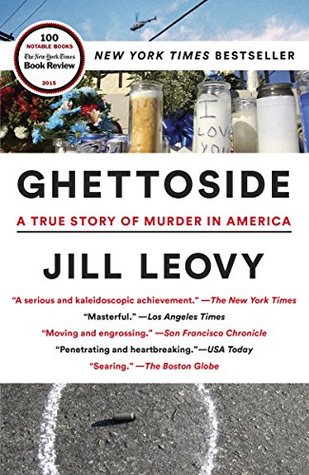More on this book
Community
Kindle Notes & Highlights
Now, having deposited the shoes in Barbara Pritchett’s hands—and having received no answer to his question—he came to a halt in the middle of the living room carpet. Pritchett remained silent, head bowed, eyes fixed on the contents of the shoebox. She was forty-two, in poor health. She had recently been diagnosed with diabetes, and her doctor had urged her to get out and walk more. But her son had been shot to death a few blocks away, and Pritchett was too frightened to venture out. She spent days lying in the dark, unable to will herself to move or speak. That morning, as always, she was
...more
This highlight has been truncated due to consecutive passage length restrictions.
This is a book about a very simple idea: where the criminal justice system fails to respond vigorously to violent injury and death, homicide becomes endemic.
Like the schoolyard bully, our criminal justice system harasses people on small pretexts but is exposed as a coward before murder. It hauls masses of black men through its machinery but fails to protect them from bodily injury and death. It is at once oppressive and inadequate.
Mysteriously, in modern-day Los Angeles, young black men are murdered two to four times more frequently than young Hispanic men, though blacks and Hispanics live in the same neighborhoods. This stands out because L.A., unlike well-known murder centers such as Detroit, has a relatively small black population, and it is in decline. By Skaggs’s time, there were few solidly black neighborhoods left; most black residents of South Los Angeles lived in majority-Hispanic neighborhoods. Yet black men died here as they died in cities with large and concentrated black populations, like New Orleans,
...more
It’s like a default setting. Wherever human beings are forced to deal with each other under conditions of weak legal authority, the Monster lurks.
In the first three years of the 1990s, that savage period spanning the riots, more than six thousand people died from homicides in Los Angeles County.
Death penalty studies, for example, have found that the race of defendants matters less than the race of victims. People who kill whites are more likely to be sentenced to death; people who kill blacks get lighter penalties.
Bryant Tennelle had entered that period of late adolescence when parents find their power reduced to suggestion and hope.
He fell into his old habit of understatement. Had he been someone else, the words he chose might have seemed deceptive.
Pointing out that this man, who had barely survived a shooting, occupied the zenith of statistical homicide risk doesn’t begin to describe the full dreadfulness of his situation. It wasn’t just that he was already lucky to be alive and that he was now being exposed as a snitch before two accused gang murderers. He was also an “underclass” black man, one of society’s outcasts. No newspaper was going to stop the presses if the man in the wheelchair got killed. No news station was going to cut into its regular programming. No detectives’ supervisor was going to yank the case away from a veteran
...more
Among the lessons to be drawn was that poverty does not necessarily engender homicide.
This fit a national pattern. Blacks lived in figurative walled cities; Hispanics did not. Black people had long been vastly more segregated from white people than Hispanics, and were more concentrated.
Yadira couldn’t stop the habit of cherishing Bryant, of thinking about him constantly in the way a mother does, planning for his future, noticing activities he might like, opportunities that might be good for him, jobs that might suit him. DeeDee was the same way. Going to work at LAX, she would notice the various municipal employees around her—the facilities crews caught her eye—and she would think of the possibilities for Bryant. The crews of men worked outdoors all day in active, hands-on jobs with decent pay and benefits—a good possibility for Bryant, she thought. It didn’t matter that he
...more
He wasn’t used to free time. He had started running at 3:30 A.M. before work. In April, he ran the Boston Marathon for charity. Friends had told him to start slow, to pace himself. Skaggs complied, though this went against all his instincts. He was still fresh at Mile 21 and finished in four hours, nine minutes, with energy to spare. “Bad tactics,” he thought. He’d violated his own creed: Never hold back.
As the last waves of Skaggs’s persistence washed over it, the defense crumbled.
And just as it is impossible to imagine that things in the South would not have been different if the legal system had operated differently—had black men’s lives, for example, been afforded profound value as measured by the response of legal authorities—it is impossible to imagine that the thousands of young men who died on the streets of Los Angeles County during Skaggs’s career would have done so had their killers anticipated a “John Skaggs Special” in every case. If every murder and every serious assault against a black man on the streets were investigated with Skaggs’s ceaseless vigor and
...more
Starks’s defense attorney Ezekiel Perlo had never heard of John Skaggs before the Tennelle case. He walked out of the courthouse on the last day of his trial career overpowered on every front by the evidence that had been assembled against his client and assuming that Skaggs must have been handpicked from the elite RHD unit to solve this case. Later, when Perlo found out that that was not so—that Skaggs was a mere divisional detective who had spent his whole career in the backwater unit of Watts and whose name had been unknown to the homicide lieutenant from headquarters—he shook his head in
...more


